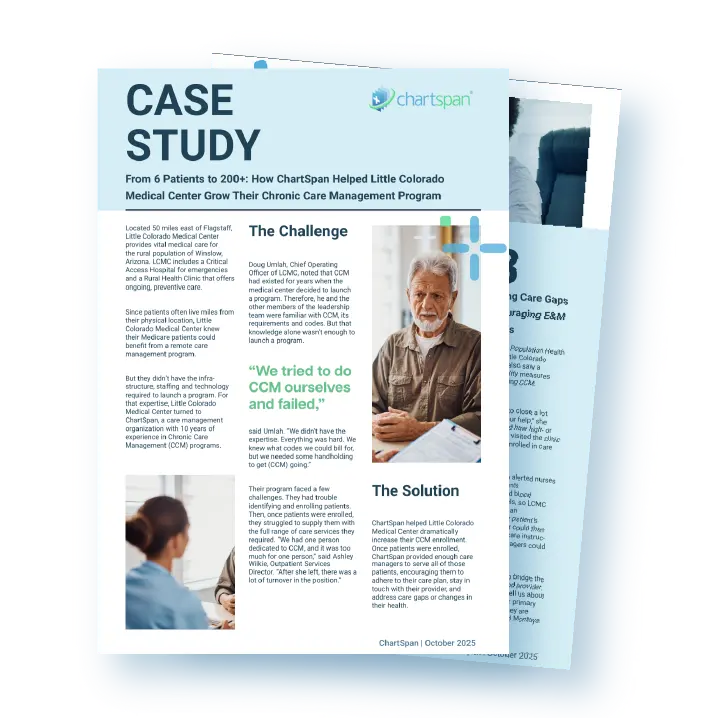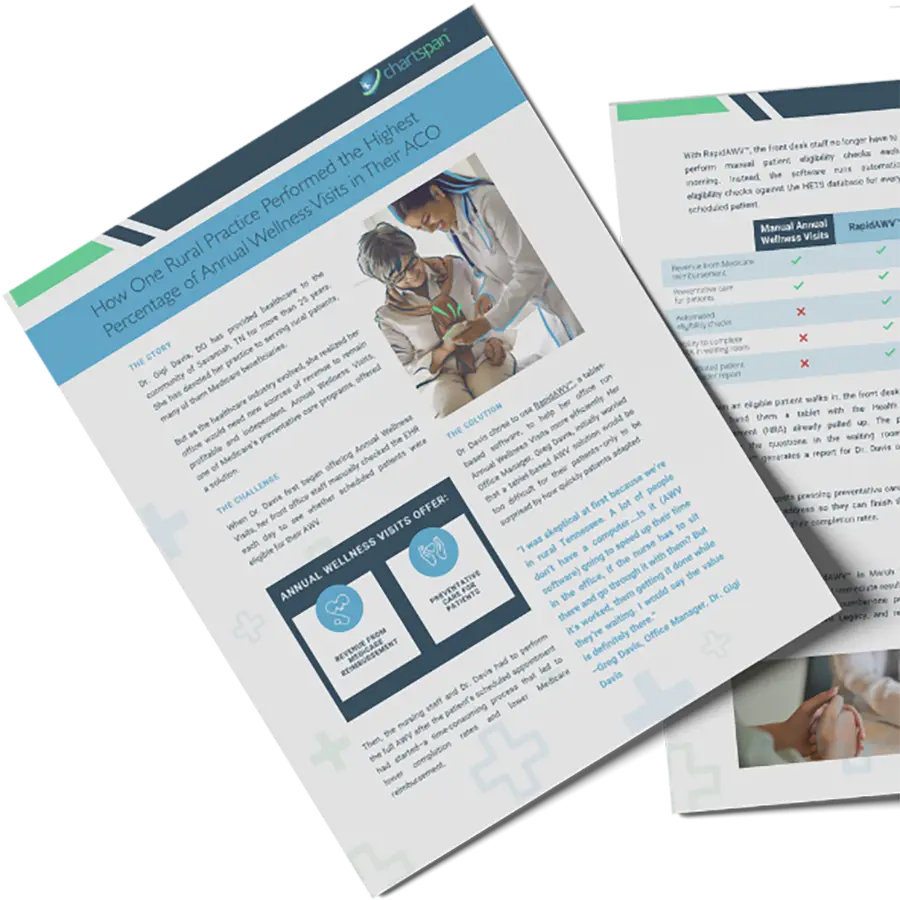
Talk with a ChartSpan Representative Today!
Our team is ready to help you improve patient care and outcomes.
Blog
Three Reasons Why Your AWV Program Isn’t Optimized…and How Annual Wellness Visit Software Can Help
If your practice is running its own Annual Wellness Visit (AWV) program, it’s likely that your program isn’t optimized to its full potential. How do you know? Because historically, 40% of Medicare patients “no show” for a scheduled Annual Wellness Visit and, according to CMS claims data, a whopping 81% of all eligible Medicare beneficiaries did not receive an Annual Wellness Visit last year. If four out of five Medicare patients are not receiving a preventative, no copay AWV, then the approach to conducting AWVs is clearly broken.
The problem is twofold. Not only are practices not optimizing their AWV programs, but some practices are avoiding AWV programs altogether. So why are Annual Wellness programs lacking? In this blog we will explore three of the main problems that AWV programs face and offer solutions.
Problem 1: Patients consistently don’t show up
The first issue that makes Annual Wellness Visit programs difficult to manage is getting patients in the door. Medicare created the AWV program to be preventive in nature, which is crucial for improved patient outcomes and lower costs. The problem is that the average patient does not usually understand the importance or urgency of timely preventive care. Most patients are used to an annual physical or regular “sick” visit and may not want to take time out of their day for an appointment that does not include a physical exam. Even with no copay obligation, patients often do not see the value in assessing their health for risk factors. This is why scheduling Annual Wellness Visits typically results in high patient no-show rates.
So what’s the best workaround to get patients to show up? Simply don’t ask them to. Instead, offer them the program when they show up to the office for their regularly scheduled appointment. Turn a “sick visit” into a “well visit.” With the right Annual Wellness Visit software, you can repurpose waiting room time into valuable time in which your Medicare patients can complete their health risk assessment (HRA). This is easily done with AWV software that is compatible with tablet devices. At check-in, the front office staff can hand the eligible patient a tablet with a preloaded HRA already on the screen. Then instead of the patient flipping through magazines as they wait for their appointment to begin, they can productively answer questions to complete their HRA. Once completed, the software can automate reports for the provider and patient to review results.
Problem 2: You don’t know who is eligible
Eligibility for Annual Wellness Visits is fairly straightforward. Medicare requires that the beneficiary has been enrolled with Medicare Part B for at least 12 months and has not had an IPPE or “Welcome to Medicare” visit within the past 12 months. At first glance this may seem easy to track, however, when you take into consideration that AWVs can be performed by a variety of providers, not just primary care, and that this information changes daily, you quickly see that eligibility is harder to track than it first seems.
If you are manually checking for eligibility in your EHR, it’s likely that you will not have the most up-to-date information since it can change daily. Additionally, if you are attempting eligibility checks against a database with any missing demographic information, you will receive an error and not be able to determine eligibility at all. That’s why it is crucial to have software that can check against an accurate database in real-time and reconcile any missing patient data.
Thankfully, the HIPAA Eligibility Transaction System (HETS) database stores all up-to-date information on Medicare beneficiaries. With software that accesses the HETS database for every eligibility check, you can ensure that you will never miss an eligible patient and will never perform an AWV on someone who is ineligible.
Problem 3: You can’t get your staff on board
Your staff already has a lot on their plate. Presenting them with a new responsibility like an AWV program is likely to overwhelm them. That’s why it is paramount that your program’s workflow is as smooth and effortless as possible. Otherwise, it may get pushed to the bottom of your staff’s responsibilities.
To have an efficient workflow, your AWV program should lean on software that can automate as much of the process for you as possible. We already explored two major components of an efficient workflow - repurposing office wait time and real-time eligibility checks. However, that only covers the beginning of the program’s process. In addition, to automate the weight of the program for your staff, your Annual Wellness Visit software should:
- Ease the patient through a user-friendly questionnaire to minimize questions for the front desk staff
- Gather critical, proactive data about your patients to help you identify gaps in care without any effort from your clinicians
- Generate a personalized prevention plan and easy-to-digest provider report that highlights the urgent, identified risk factors at a quick glance
- Offer an easy approach to billing so you can maximize your reimbursements while minimizing your billers’ labor
If your AWV software does not have these capabilities, your program will struggle to achieve acceptable patient utilization ratios and not interrupt the daily clinical workflows of your frustrated staff. Don’t let your Annual Wellness program fall to the wayside. If you are interested in software that can solve the top three problems that AWV programs face, reach out to us today.
Subscribe for More Insights
Get valuable resources delivered straight to your inbox.
"*" indicates required fields






